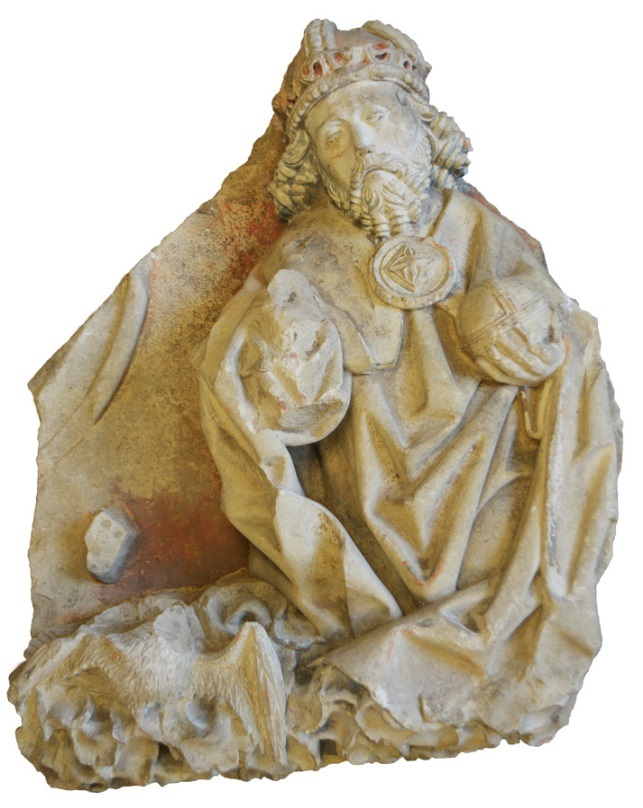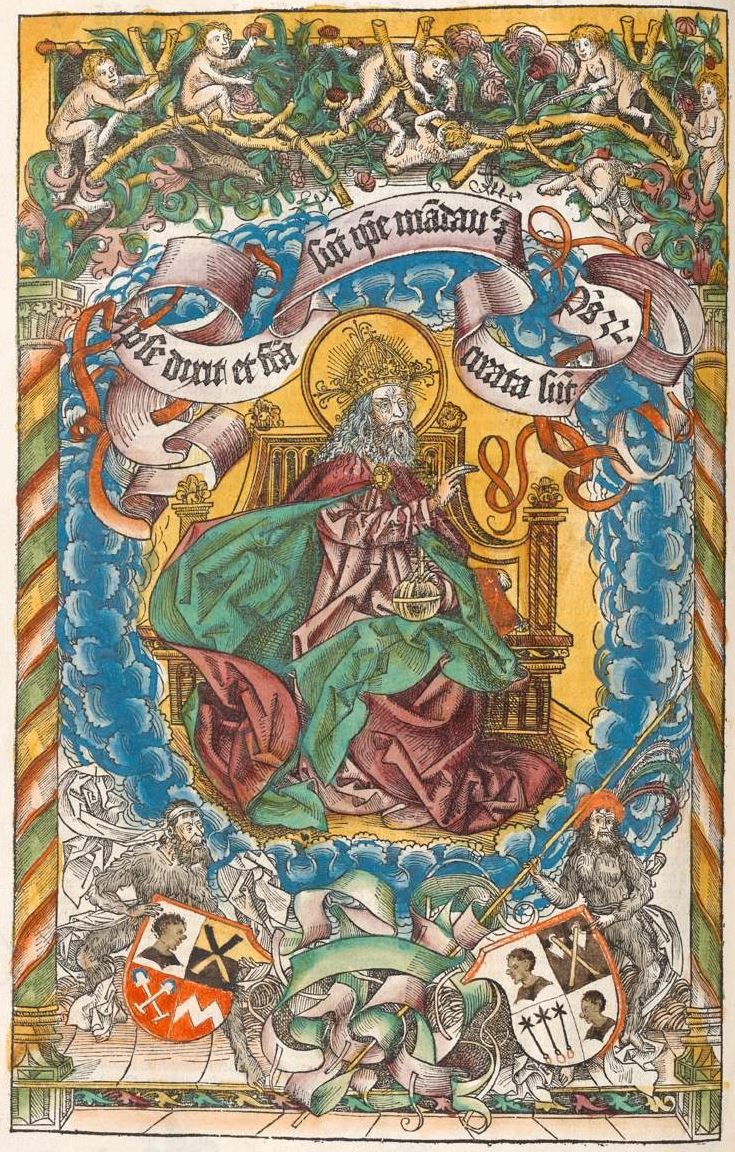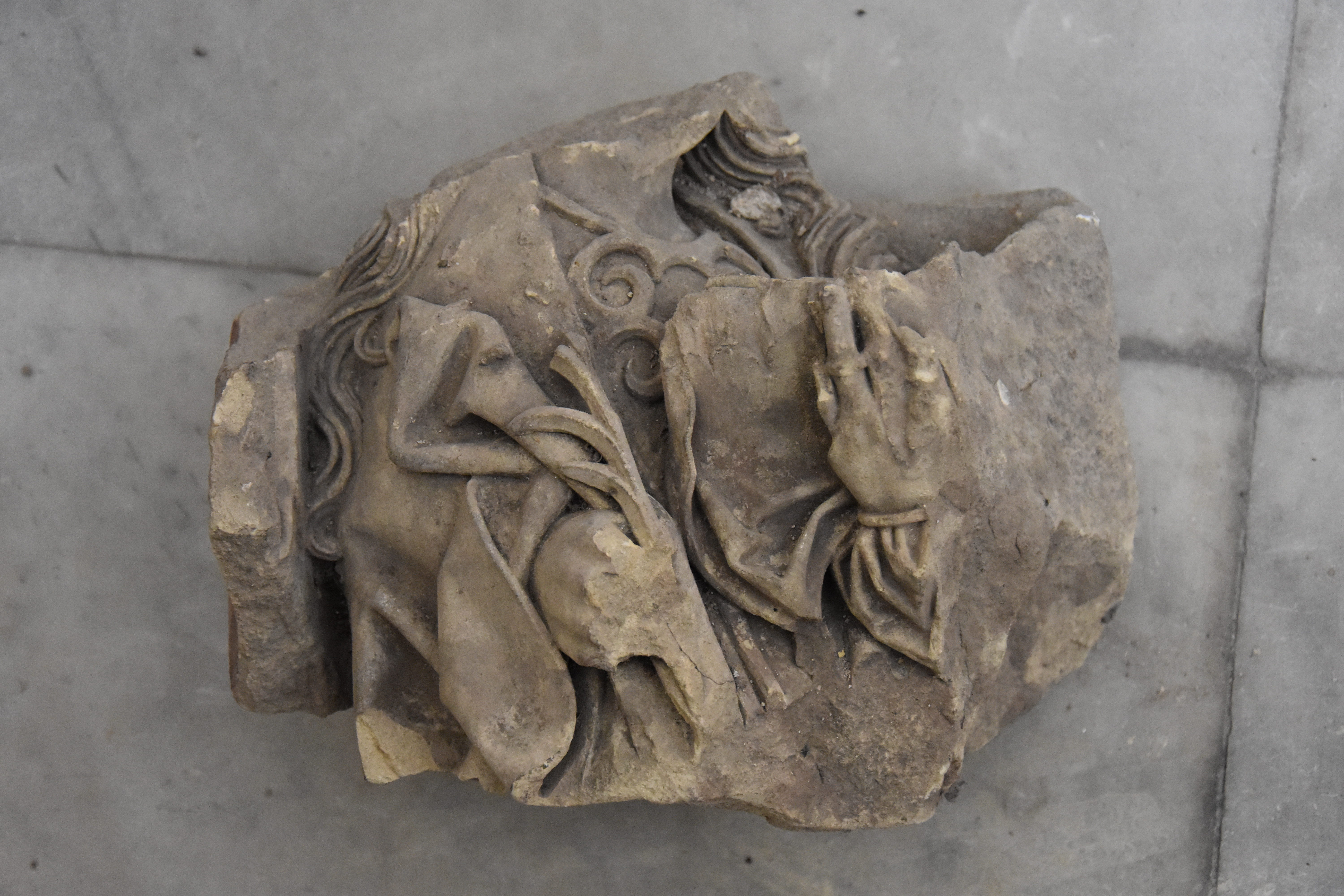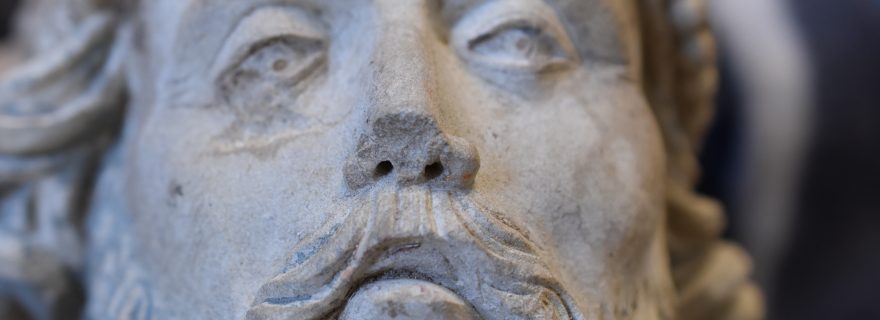A damaged God-the-Father figure from Zutphen
A religious sculpture was buried under a church floor. But who had put it there? And why was it mutilated?
In 2018, an intriguing sculpture of God-the-Father was found face-down under the floor of the church of St Walburgis in Zutphen, against the northwestern pier of the choir. Initially, it was thought that the relief had been placed there after being mutilated by sixteenth-century iconoclasts of the protestant faith. However, the damage done to the relief does not seem to support this idea. Protestants usually went for the head and face, in an attempt to stop the image’s agency. Here, it is not so much the head of God-the-Father but his right arm, crown and the bird at his feet that have taken the blows. So what was going on here?
The relief
The relief is made of Baumberger stone and measures 43 cm by 55 cm (fig. 1). Against a red background, the three-quarter figure of God-the-Father is featured, rising from a cloud that indicates the heavenly sphere. He is shown wearing a mantle closed by a round fibula under the chin and a German royal or imperial crown. In his right hand he holds a globe, his left hand has been severed, but in all likelihood it once supported a scepter. On the left (from the viewer’s perspective) are the remains of a bird, possibly an eagle, with outspread wings, and above the remains of a foliage tendril or an angel’s wing. It is clear that the relief was once part of a larger whole, but with so much having disappeared it is impossible to identify the precise iconography.

Fig. 1: God-the-Father relief found in 2018 (Photo Archeologische dienst Zutphen).
God as Emperor, Emperor as God?
The double-hooped crown worn by the God-the-Father figure is striking. It consists of a ring decorated with pearls supporting a series of fleurons that have all been topped (fig. 2). In addition, there are four brackets with a pearl rim decoration that meet at the top, where the central feature has disappeared. This clearly is a German royal crown, albeit not the so-called imperial crown that was believed to have belonged to Charlemagne and which was used for coronation ceremonies. What we see on the relief is a so-called "Hauskrone" or private crown, of which the successive German kings and emperors had several. Such private crowns were worn at all other ceremonial gatherings and they, as did the imperial crown, expressed that the bearer was king of the Holy Roman Empire. It is this type of crown that, starting with the reign of the king Wenzel (1361-1419), is usually shown on images of the German rulers.

Fig. 2: Detail of God’s head with the double-hooped crown (photo author).
From the fifteenth century, images of God-the-Father increasingly picture him wearing a German royal double-hooped crown (fig. 3), underlying , of course, that the king or emperor owed his power directly to God, that he was, so to speak, God’s representative on earth. This type of imagery was especially popular during the reigns of the Habsburg Emperor Frederick III (1415-1493) and his son Maximilian, who was crowned King of the Holy Roman Empire in Aachen in 1486, became emperor in 1508 and died in 1519. Images of these rulers show that Emperor Ferdinand III, until the 1480s, tended to adorn himself with the double-hooped as well as with a miter-like crown. Maximilian also went for the double-hooped crown, especially in the early days of his kingship. Unfortunately, none of their personal crowns have been preserved, as their descendent King Philips II of Spain had no interest in crowns and put the collection he inherited for sale in 1562.

Fig. 3: God-the-Father, Schedelsche Weltchronik (Bayerische Staatsbibliothek München).
Zutphen and Maximilian
Now there was a direct relationship between Zutphen, Frederik III and Maximilian. How that came about is a complicated story.
In 1423, Arnold van Egmond succeeded his maternal great-uncle, Reinald IV of Gelre, as Duke of Gelre and Count of Zutphen. In 1465, he was captured and deposed by none other than his own son Adolf. The Burgundian duke Charles the Bold freed Arnold from this captivity in 1471 and imprisoned Adolf in Flanders. In 1472, in order to obtain money, Arnold pledged his possessions to Charles the Bold for 300,000 guilders, which is reason why the Burgundians could claim the duchy of Gelre and the county of Zutphen as their own. When Arnold died a year later, Zutphen acknowledged the claim of Adolf van Egmond to his father’s titles. Charles the Bold retaliated by seizing the city, expecting its citizens to pay him homage. The emperor Frederick III formally instated him with Gelre and Zutphen in 1473. Charles the Bold’s unexpected death in 1477 resulted in a power vacuum, Charles's heir being his young daughter Mary. The inhabitants of Gelre and Zutphen again chose Adolf as their ruler. As he stayed in Flanders to help Mary of Burgundy hold on to her heritage, his sister Catharine was appointed regent in Gelre and Zutphen. However, Adolf died before the walls of Tournai shortly after. While Mary continued to look after his two young children, who were being raised at her court, she also married Maximilian of Austria, the son of King and Emperor Frederick III. With Adolf’s children as hostages, he began to set his eyes on Gelre from 1479 onwards. Catharine, Adolf’s sister and regent, was soon forced to surrender the southern parts of Gelre. The north of Gelre and Zutphen, refused to return to the Burgundian yoke, and Zutphen even elected the bishop of Münster as its ruler. He, unfortunately, proved unable to resist the Burgundians and surrendered to them in 1481. When in 1482 Mary of Burgundy died, the tide changed, and Maximilian struggled to keep on to his wife’s legacy but succeeded. Maximilian’s domination of Zutphen lasted until 1492, when the city decided to back Charles of Egmond (the son of Adolf), resulting in a struggle that was to last for decades.
In 1492 then, the city of Zutphen turned its back on the German emperor Frederick III and his son Maximilian. It seems to me that from 1492 onwards the citizens of Zutphen would not have welcomed an image of God-the-Father wearing a German crown, a type of imagery that had been developed as Habsburg propaganda.
The damage done to the image
When, during excavations, mutilated pieces of sculptures are brought to light, the mutilations are generally related to the sixteenth-century iconoclasm perpetrated by the protestants and the period of reform that followed. The St Walburgis church was indeed repeatedly looted and damaged between in 1572 and 1598, when it was finally confiscated by the protestants. It is thus conceivable that the God-the-Father relief and the greater whole of which it once formed a part was broken up during this period. There are, however, strong reasons to think otherwise.
When, during the Reformation period, iconoclasts and soldiers smashed images, they never forgot to target the heads, in order to diminish the sculptures’ expressive power, their ‘agency’. At the very least, noses were chopped off and eyes scratched out. In one of the northern side chapels of the Zutphen choir, a series of broken and damaged stones shows off to perfection the sort of damage inflicted on statuary by protestant iconoclasts. For instance, there is a fragment of a statue of a female martyr, who is recognizable as such by what remains of her long locks, the book on her arm and palm branch in her right hand (fig. 4). Yet, her head has been removed, as has her right hand. A remnant of a figure of Saint John the Baptist, identifiable by his camel-hair robe, is without arms and of his head only the strands of his beard remain. In a relief of a resurrection group, the heads of the souls going to heaven and of the angels accompanying the souls have largely been removed. On the preserved epitaphs, the heads of saints and donors have also been cut away. Figures of the crucified Christ and the Pieta, in which Mary has the dead Christ on her lap, have been tackled in the same ruthless manner (fig. 5).


By contrast, the Zutphen God-the-Fatherfigure, even though such representations were considered highly reprehensible by those of the protestant faith, bears no such injuries. In fact, he is surprisingly intact. All that is missing is the tip of his nose and there is a little damage under his left eye. The crown on his head is somewhat damaged, its top having disappeared and the upper parts of the fleurons being lopped off. His right arm, that probably held a scepter, is gone, and the bird at God's feet has been severely damaged. This suggests that it was not the figure of God that incurred the wrath of whoever mutilated the relief, but the symbols of the German Empire - the scepter, crown and the bird (possibly an eagle). It therefore sees reasonable to assume that the relief was destroyed in 1492 or in the decades thereafter, when Zutphen was at war with the German king and emperor.
© Elizabeth den Hartog and Leiden Medievalists Blog, 2019. Unauthorised use and/or duplication of this material without express and written permission from this site’s author and/or owner is strictly prohibited. Excerpts and links may be used, provided that full and clear credit is given to Elizabeth den Hartog and Leiden Medievalists Blog with appropriate and specific direction to the original content.


